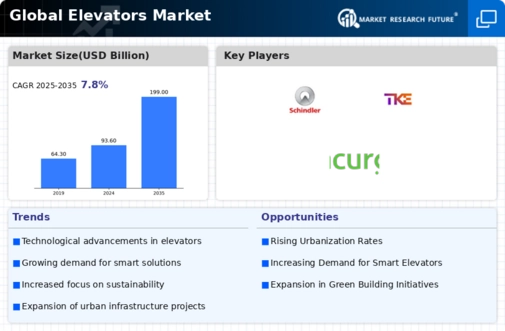Market Analysis
In-depth Analysis of Elevators Market Industry Landscape
Green engineering, part of the elevator sector, may optimize performance by collecting extra energy. Wasted heat is commonly created. The market system recycles collected energy into the building's electric grid. Building projects require almost 40% of global energy, with elevators requiring 2%–10%. Modernizing construction processes with smart building technologies may reduce this figure to 1–5%. The green engineering idea may allow market participants to deliver energy-efficient solutions to save operating expenses by automating and modernizing elevators. Numerous variables affecting supply and demand are changing the elevators market. Urbanization, technological advances, and the necessity for efficient transit in buildings are driving elevator demand. Global urbanization drives market dynamics. Elevators have become essential to contemporary urban infrastructure as cities grow vertically with high-rise structures and skyscrapers, improving construction market dynamics. The building and real estate industries strongly impact elevator markets. Vertical transportation systems must be dependable and improved as urban development initiatives continue. New construction and refurbishment and upgrading of existing buildings to satisfy safety and efficiency requirements boost elevator demand, affecting construction and real estate market dynamics. Technology drives elevator market dynamics. Smart technology, energy-efficient features, and sophisticated safety measures are popular. Elevator manufacturers are using IoT connectivity, machine learning, and destination dispatch systems to improve performance, energy consumption, and user experience, aligning with the smart building trend. Sustainable and green construction approaches are also changing market dynamics. Sustainable, energy-efficient elevators are growing. As environmental concerns become more important in the construction industry, manufacturers are developing eco-friendly materials, energy-efficient systems, and regenerative drive technologies to meet demand for green building solutions and influence market dynamics. Demographic changes like an aging population can affect elevator market dynamics. Ageing societies need elevators with improved accessibility. Elevators with user-friendly controls, large cabins, and safety features meet the accessibility and inclusiveness demands of an elderly society, improving market dynamics. Elevator market dynamics depend on regulatory requirements and safety rules. Governments and regulators set elevator installation and operating safety requirements. Manufacturers and service providers must follow these standards to ensure elevator system and component safety and dependability, impacting market dynamics. Global economic factors and real estate developments affect elevator market dynamics. Economic development and building investment boost elevator demand. Conversely, economic downturns or real estate market changes may slow new building, influencing elevator installation and upgrade demand and market dynamics. Manufacturing, technical innovation, and tailored solutions affect market dynamics on the supply side. Research and development, product innovation, and customized solutions for various building types provide elevator manufacturers a competitive edge, affecting market supply side dynamics.






Leave a Comment